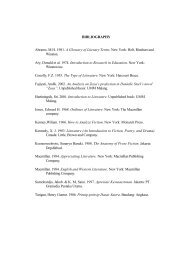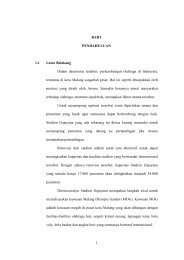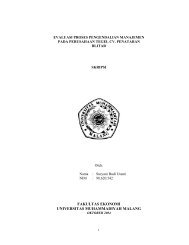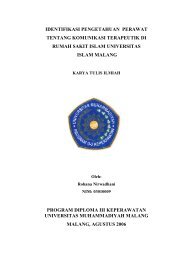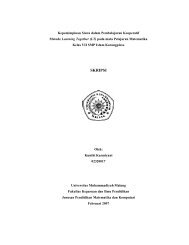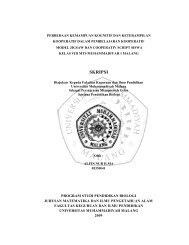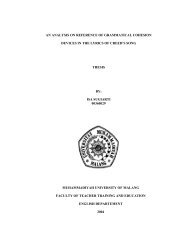File : THESIS.pdf - Universitas Muhammadiyah Malang
File : THESIS.pdf - Universitas Muhammadiyah Malang
File : THESIS.pdf - Universitas Muhammadiyah Malang
You also want an ePaper? Increase the reach of your titles
YUMPU automatically turns print PDFs into web optimized ePapers that Google loves.
Candidates should be able to:<br />
BIOLOGY 9700 A/AS LEVEL<br />
(a) describe and explain the fluid mosaic model of membrane structure, including an<br />
outline of the roles of phospholipids, cholesterol, glycolipids, proteins and<br />
glycoproteins;<br />
(b) outline the roles of membranes within cells and at the surface of cells;<br />
(c) describe and explain the processes of diffusion, osmosis, active transport,<br />
facilitated diffusion, endocytosis and exocytosis (terminology described in the<br />
IOB’s publication Biological Nomenclature should be used; no calculations<br />
involving water potential will be set);<br />
(d) *investigate the effects on plant cells of immersion in solutions of different water<br />
potential;<br />
(e) use the knowledge gained in this section in new situations or to solve related problems.<br />
E CELL AND NUCLEAR DIVISION<br />
Content<br />
Replication and division of nuclei and cells<br />
Understanding of chromosome behaviour in mitosis<br />
Learning Outcomes<br />
Candidates should be able to:<br />
(a) explain the importance of mitosis in growth, repair and asexual reproduction;<br />
(b) explain the need for the production of genetically identical cells and fine<br />
control of replication;<br />
(c) explain how uncontrolled cell division can result in cancer and identify factors<br />
that can increase the chances of cancerous growth;<br />
(d) *describe, with the aid of diagrams, the behaviour of chromosomes during the<br />
mitotic cell cycle and the associated behaviour of the nuclear envelope, cell<br />
membrane, centrioles and spindle (names of the main stages are expected);<br />
(e) explain the meanings of the terms haploid and diploid and the need for a reduction<br />
division prior to fertilisation in sexual reproduction;<br />
(f) use the knowledge gained in this section in new situations or to solve related problems.<br />
F GENETIC CONTROL<br />
Content<br />
The structure and replication of<br />
DNA The role of DNA in protein<br />
synthesis<br />
Learning Outcomes<br />
Candidates should be able to:<br />
(a) describe the structure of RNA and DNA and explain the importance of base<br />
pairing and hydrogen bonding;<br />
(b) explain how DNA replicates semi-conservatively during interphase;<br />
(c) state that a gene is a sequence of nucleotides as part of a DNA molecule, which<br />
codes for a polypeptide;<br />
(d) describe the way in which the nucleotide sequence codes for the amino acid<br />
sequence in a polypeptide;<br />
(e) describe how the information on DNA is used to construct polypeptides, including the<br />
role of messenger RNA, transfer RNA and the ribosomes;<br />
(f) explain that, as enzymes are proteins, their synthesis is controlled by DNA;<br />
118



